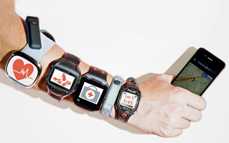Nowhere is the utility of big data greater than in healthcare, and by inference, health insurance. Venture capitalists appear to have caught on to this, and in the first quarter of 2016, put USD 1.4 billion into the hands of healthcare IT companies. This was almost a third more than in the previous quarter, with much of it directed towards wearables, data analytics and telemedicine.
#1: The Cost Challenge
Three key trends are driving the big data revolution in healthcare. The most important of these is the desperate need, in a world that is rapidly aging, to stem ever-rising healthcare costs. This is a need shared by all healthcare stakeholders, from consumers and providers, to insurers and government agencies.
While cost saving is not a new item on the global healthcare agenda, the recent spotlight on “value-for-money” health services is in part the result of the U.S.’s Affordable Care Act. Faced with ACA requirements, “merger mania” has broken out among healthcare insurers, according to the PwC Health Research Institute.
It would be fair to say that these proposed insurance mega-mergers have been met with some scepticism. Opponents fear that the much-touted economies of scale may not materialise. However, proponents and opponents alike agree that insurance company mergers do offer a key opportunity: to optimise their IT infrastructure, and leverage on innovations in mobile health applications and analytics.
#2: Monitoring on the move
This brings us to the second unmissable trend – the rise of activity trackers and medical devices. Increasingly, health monitoring is shifting from the hospital and clinic to the home and on-the-go. Given that the management of chronic diseases is already the largest component of U.S. healthcare spending, Goldman Sachs suggests that remote health monitoring is “at the bulls-eye of the healthcare cost challenge”.
But the power of health monitoring devices is not just the ability to save money. Health and fitness monitoring devices are enjoying a huge surge in popularity. According to IDC, 78.1 million wearables were shipped in 2015, up from 28.8 million the previous year. PwC’s recent survey suggests that one in three American consumers now have at least one medical, health or fitness app on their mobile devices.
What this means is that the healthcare industry is no longer just reliant on clinical data. Health-related digital data is now (potentially) on tap from medical and fitness devices. The question is whether the data is being put to good use. To date, many healthcare and device providers have been reticent to do so, amid concerns that personal data sharing would be unpalatable to patients and users. The PwC survey appears to lay this to rest, with 83% of respondents indicating their willingness to share their data to help their own diagnosis and treatment, and 73% to help others.
#3: Prevention not cure
This level of acceptance may stem from the already signifiant strides in healthcare analytics, particularly in the area of patient risk forecasting. For example, by analysing patients’ everyday behaviours, socio-economic factors, and clinical updates, hospitals are now predicting and where possible, preventing, their post-operative health deterioration. It is perhaps not surprising that, in a recent survey, advanced analytics was found to be more prevalent among mid-sized U.S. hospitals, ie those between 100 – 500 beds, where there is a strong incentive to minimise patient re-admissions.
Furthermore, in the last few years, healthcare analytics have expanded to include healthy individuals with specific health vulnerabilities. Individuals at risk are offered wearables that track their vital statistics and surroundings, and analytics help primary care doctors to determine if a change in preventive medication or lifestyle is required.
Then there are the individuals who are tracked and rewarded simply for staying healthy. Employers, partnering with insurance players like United Health, Kaiser Foundation Group, Humana Group and Aetna, now account for the fastest sales of wearables. By agreeing to have their activity levels monitored and analysed, employees are able to lower their health insurance premiums as part of so-called “corporate wellness programs”.
A data-hungry future
Given the pace of adoption of wearables and healthcare analytics, there is an appetite for data that may well grow to point of becoming insatiable. Already, insurance companies are said to be busy approaching app developers in an attempt to directly access their fitness data.
By applying sophisticated analytics to large and varied datasets, insurers are hoping to refine their insurance plans. On the horizon looms a cut-throat health insurance marketplace, with new players such as hospitals and primary healthcare providers joining the fray. To stay competitive, health plans could evolve from annual and generalised premiums to daily-adjusted, personalised rates, based on an individual’s real time fitness data. This data will be generated by devices that insurers will offer at discounted rates or for free, further elevating data volumes and the performance of healthcare analytics.
Can you think of a more compelling virtuous cycle?

